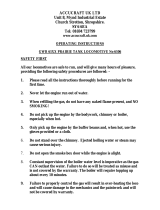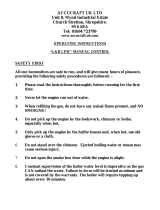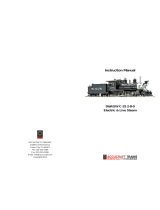Page is loading ...

1
ACCUCRAFT UK LTD
Unit 4, Long Meadow Industrial Estate,
Pontrilas, Herefordshire. HR2 0UA
Tel: 01981 241380
www.accucraft.uk.com
OPERATING INSTRUCTIONS
“FLYING SCOTSMAN”
SAFETY FIRST
All our locomotives are safe to run, and will give many hours of
pleasure, providing the following safety procedures are followed: -
1. Please read the instructions thoroughly before running for
the first time.
2. Never let the engine run out of water.
3. When refilling the gas, do not have any naked flame present,
and NO SMOKING!
4. Do not pick up the engine by the bodywork, chimney or
boiler, especially when hot.
5. Only pick up the engine by the buffer beams and, when hot,
use old gloves or a cloth.
6. Do not stand over the chimney. Ejected boiling water or
steam may cause serious injury.
7. Do not open the smoke box door while the engine is alight.

2
General Hints
As with all operating machinery, whether model or full size, wear will
occur. In the model steam locomotive much can be done to help
prolong its life and decrease the amount of time required in the
workshop for servicing.
Keep the engine as clean as possible, and the motion free from dirt
and garden debris. The valve gear, axles and crank pins should be
oiled sparingly with light oil, e.g. “3-in -1 Oil”. Over-oiling attracts
dirt and grit, which will increase wear.
Regularly check that all screws and motion bolts are firm. Do not
over-tighten, as this strips threads and shears bolts. When filling the
lubricator, always use a high temperature steam oil; this is
available from other retailers. FAILURE TO USE THE
CORRECT GRADE OF OIL CAN LEAD TO BLOCKED
STEAM PIPES, AND WILL INVALIDATE THE GUARANTEE.
When running your engine avoid excessive speed and acceleration,
both will cause premature wear in the valve gear.
Positions of Fillers, Controls, and Drains etc.
The gas inlet valve is in the small turret situated on the top of the gas
tank which is in the tender. To access it lift out the coal load, this can
be a little tricky but can be achieved by lifting out on a slight angle.
The gas control valve is on the front footplate of the tender.
The lubricator is in the front footplate just in front of the smoke box.
To drain out the condensed water from the previous run use the small
syringe provided, with the short length of tube supplied, attached.
The boiler water is contained in the tender in the tank that surrounds
the gas tank. On the first fill use ‘hand hot water’ only. This is to
keep the gas tank warm so the gas will vaporise freely. DO NOT USE
BOILING WATER. This could over stress the gas tank and will
invalidate the warranty.

3
The axle pump by-pass valve is in the cab on the right hand side. See
photo. To open the valve turn anti-clockwise.
The direction control is the lever in the nearside of the cab. To
operate pull gently outwards and move to the desired direction. The
control is “gated”, and will therefore hold itself in the full forward or
reverse position.
The steam throttle is the valve on the back of the boiler. Although it
looks prototypical, BEWARE, it gets hot!
The cab roof lifts up to give access to the cab interior and the controls.
Preparation for Running
Connect the tender to the locomotive by pulling out the copper water
feed and return pipes and pushing them into the connectors under the
fall plate of the cab. Check they are fully in by giving them a little pull
backwards. Then connect the loco to the tender using the draw bar.
Place the gas jet holder into the burner on the back of the boiler. To
remove the water pipes hold the pipe and press the ring on the fitting,
the pipe can then be withdrawn. They can be a little tight!
Always service the engine in the following order; first gas, oil then
water.
To fill the gas tank: invert the gas can and apply the nipple to the gas
inlet valve on the top of the tank turret. You will know when the tank
is full; gas will blow back from the inlet valve in a strong jet. A small
amount of gas and air will escape during filling, but the difference
between this and when the tank is full is always clear. Always keep
the gas can vertical when filling the gas tank. We recommend that
Butane gas is used whenever possible, but the gas tank is
manufactured to accept the extra pressures generated by
Butane/Propane mix gases, and the burner system will also perform
using this gas.
Filling the lubricator: as you will read in the instructions for the end
of the run, the lubricator should be empty of oil and water. Remove
the screw cap just in front of the smoke box door. Fill up the
lubricator with steam oil to about ¼ of an inch below the top. Leave

4
the filler cap off for the present, so that any trapped air can escape. It
can be refitted after you have filled up the boiler.
To fill the boiler: Using the long brass lever supplied, fit it onto the
the hand pump in the tender and fill up the boiler to about ¾ full; this
will allow a good space for a ‘head of steam’. Ideally use filtered
rainwater or distilled water. Check that the lubricator does not need
topping up, and then replace its filler cap. The filler cap should be
firm finger tight. It is sealed with a trapped ‘O’ ring and, therefore
should not be over-tightened.
Lighting Up
Open the smoke box door; just pull it open by the door handle. Light
your lighter/match etc. and gently open the gas control valve until a
gentle hiss is heard in the burner. Apply your light into the smoke box
and the flame should ‘pop’ down the fire tube and ignite the burner
inside the fire tube.
If the gas valve is opened too much the flame will not pop back; it will
either fail to ignite, will roar in flame out of the smoke box, or there
will be a ball of flame around the front of the engine, which will then
blow the whole fire out (after giving the driver a fright)!
When the fire sound has stabilised, after about 30 seconds the gas can
be turned up gently. Do not turn the gas up high as the flame could
damage the paint on the smoke box door. The smoke box door may be
shut after about two minutes. Now leave the locomotive to raise
steam.
When pressure starts to rise, water will be seen running out of the
boiler blow down valve. When the water reaches its correct level
steam will be seen. Now screw shut the check valve and let the
locomotive raise at least 50 p.s.i.
Running
When the engine has raised about 50 psi, you are ready to start
running. The locomotive cylinders are fitted with drain valves, these
are the rods underneath the cylinders. To operate turn the little lever at
the front through 90 degrees. Before commencing your first run of the
day, it is advisable to put a cloth loosely over the chimney for a few
minutes, as condensed water can be ejected from the chimney. This is
quite normal; the motion of the engine will be jerky until all

5
condensate has been ejected. DO
NOT stand over the chimney as
ejected boiling water/steam could cause serious scalding.
Place the direction lever into the reverse position, and then open the
main steam throttle valve. The engine should start to move off in the
reverse direction. When starting from cold it will be jerky, this is
normal, as it has to clear the condensate from the system. The more
the main steam valve is opened, the faster the engine will go; our
advice is to start slowly and learn the road with your engine
After a minute or so, remove the cloth and continue running. In
running it is correct practice to balance the boiler pressure against the
load being pulled and the track conditions. With a light load and level
track the pressure may need to be only 40-50 p.s.i. therefore, turn the
gas control down to keep this pressure. When running a heavy train
with steep gradients, increase the pressure by turning up the gas.
The ideal running pressure can be learnt by experience and is one of
the pleasures of running a live steam engine. There is no need to have
the safety valve constantly blowing off (it is what its name implies – a
safety vent for excess steam pressure).
This locomotive is equipped with an axle pump and bypass valve. The
pump moves water from the tender to a check valve on the
locomotive. The bypass valve is located on the back right hand side of
the cab. When the bypass valve is completely shut, water is pumped
into the locomotive. When the bypass valve is open, the pump will re-
circulate water back into the tender. With careful adjustments of this
valve, the engine will always have enough water to keep running for
long periods of time until the tender water tank needs to be refilled.
The tender is also equipped with the hand pump, which needs to be
used to prime the axle pump and initially fill the boiler. Only two or
three strokes are necessary to prime the pump.
When the gas runs out a complete gas and oil service must be done,
remember to shut the gas regulator before refilling the gas tank, and
DO NOT refill with gas near any other live steam loco).

6
End of Run
When the last run has finished the locomotive should be allowed to
cool. When cool, clean the engine, check the motion and oil if
necessary. The locomotive should always be put away in a clean
condition as it attracts less dust and is always ready for the next run
(or to be shown to an admiring friend). It is advisable to store the
locomotive where any residual drips of oil or water do not matter.
Blocked Gas Jets
If the gas jet becomes blocked with particles of dirt within the gas, the
jet will have to be removed and cleaned. With a spanner or pliers
carefully undo the pipe union on the gas control valve. Remove the
pipe and jet holder assembly from the burner.
Holding the jet holder gently in a vice, unscrew the jet. To clear, place
the jet nozzle against the inverted gas can nozzle and clear the jet with
a blast of gas. Under no circumstances use a pricker wire, this will
damage the jet hole. Replace the jet in the holder, ideally using a
thread sealant sparingly on the threads. Ensure it is tightened up
firmly. Replace the assembly into the burner and re-connect the pipe
to the control valve. Ensure this is done up tightly, test CAREFULLY
for gas leaks, first with a 50/50 mixture of washing up liquid and
water, and then if no bubbles are showing, with a flame and the gas
“just on”. Tighten if required.
***************
As with all our models, we strongly recommend a full demonstration
(by our agents) before purchase, enabling you to get the best out of
your model right from the start.
HAPPY STEAMING

7
Tools supplied:
A: Name plates, these slip on over the lugs on the centre wheel
splashers.
B: Tender hand pump extension lever.
C: Large syringe, not really required for this model.
D: Small syringe and tube, for draining the lubricator.
E: Bag of spare bolts and hex wrenches.
F: Nut spinners.
G: Extension tool to aid reaching the gas control valve.

8
Tender Parts:
A: Hand pump. B: Gas tank filler valve. C: Gas control valve.
Cab Parts:
A: Steam throttle valve. B: Axle pump by-pass valve.
C: Water gauge. D: Direction lever.
E: Pressure gauge. F: Water pipe connectors.
/















